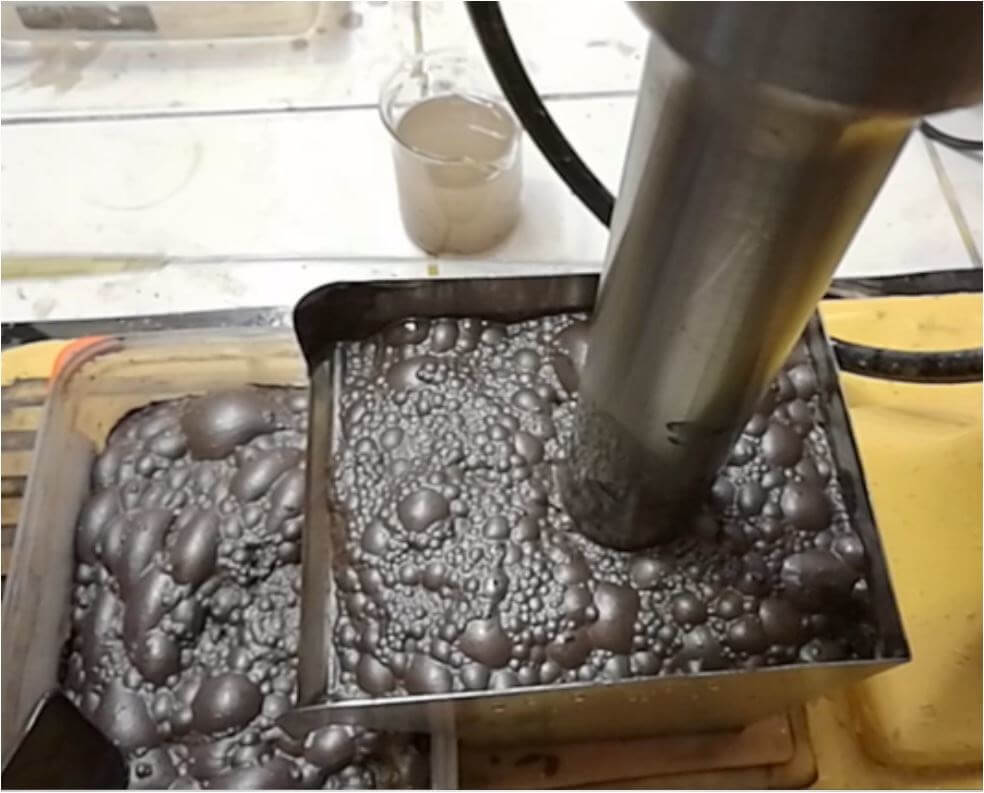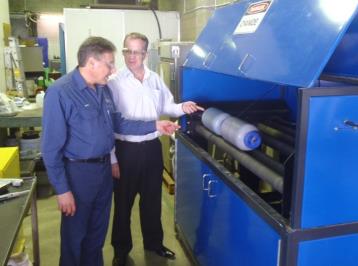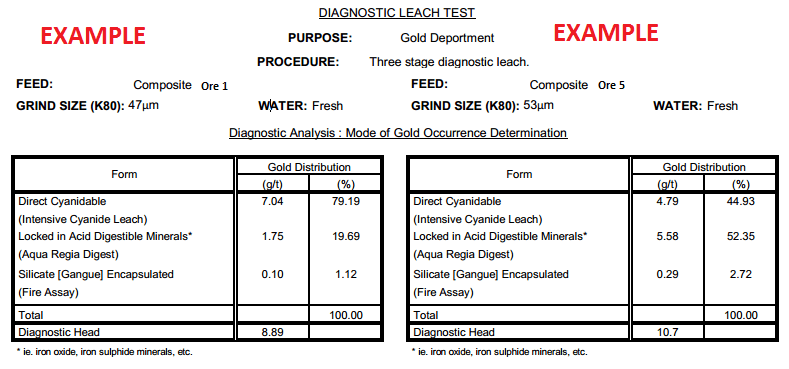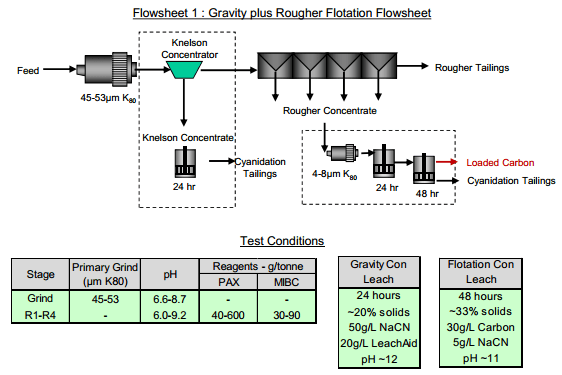Table of Contents
Metallurgical testing and corresponding flowsheet development programs involve acquisition of certain basic information, a laboratory testing phase, the preparation of reports and, finally, flowsheet development.
Management of the basic information includes information relevant to location, the nature of the ore body, sampling, marketing and specifications, environmental guidelines, and a review of literature and current practice.
The laboratory testing phase can be substantial and may cover the following: crushing, grinding, regrinding, classification, flotation with a study of reagent types and quantities, pulp density, aeration and conditioning, pH regulation, retention time, temperature, water quality, sample ageing and cycle tests. Further testwork could include: sand-slime separation, gravity and heavy media concentration, leaching, calcining, solvent extraction, ion exchange, magnetic and electrostatic separation, microscopic studies, pumping, thickening, filtering, effluent treatment and environmental research. Equipment is finally selected.

Flowsheet development may rely on pilot work; the final result is a process flowsheet.
There are a great number of tests available to the metallurgist but no ore would need to be subjected to all of them. Experience will dictate those which should be employed and problems encountered will force attention to other less-common techniques. Bench testing of ore samples is one of the most important steps in the long series of metallurgical and economic studies involved in bringing new mines into production. If these investigations are not thorough, many questions and problems that develop during the research programs, in mill design engineering and later during operations can be traced to inadequate or improperly interpreted laboratory test data. Experimental programs should not be terminated until a satisfactory general flowsheet with all requirements from crushing to tailing disposal and concentrate load-out are met.
The laboratory testing does not terminate when the operations commence. On a regular routine basis, bench tests, using a standardized laboratory procedure, can be used to determine the differences in ore types, responses, reagents and flowsheet changes required during the operating life of the orebody. They also can be used to develop or test new techniques or processes prior to the full scale pilot trials. If favourable. results can be obtained in the laboratory under control led conditions, the flotation engineer gains assurance that “it can be done” and thus new, improved, achievable objectives can be established for the operations. The pilot plant concentrate production can be used by the potential buyers for their own metallurgical research. Finally, laboratory tests and pilot plant programs can be used to advantage to train mill operators, particularly those responsible for flotation.
The amount and type of metallurgical testing to be performed on any mineralized samples will vary with each circumstance. Very little work may be necessary when developing flowsheets for new processing facilities to treat ore from an enlarged existing plant or a new adjacent orebody while conversely, years of research may be required for a complex ore far from other plants and test facilities or in a completely different environment. This testing is an ongoing activity from discovery to eventual abandonment.
The initial research program in the metallurgical laboratory develops the general flowsheet which may be verified in the pilot plant depending on the complexity disclosed. Also, at this stage, the profitability of the project may be confirmed or placed in doubt before expenditures have become excessive. The flowsheet used for design and construction can be rearranged in degree following the commencement of production during the tune-up phase and may take years to optimise.
What samples are available for testing purposes and which samples are the most suitable for the research contemplated? There is no single answer to these questions as each case is different but one can be more confident of the results if a wide variety of samples rather than a large quantity of a limited number of types is provided. As the various stages of the research are contemplated, the metallurgist may be provided with surface hand samples, diamond drill core, trench samples or samples from stockpiles. As mine development progresses, bulk lots for the laboratory, the pilot plant and/or autogenous grinding tests should become available. Initial quantities preferred for bench tests range from 1 to 3 kilograms depending on complexity anticipated while the pilot plant may require hundreds of tons.
With respect to samples, two very important prerequisites to a good research program are that they should be representative and fresh. Split diamond drill, core is most frequently available today but the quantities are limited because the geologists will keep a portion, various, government agencies may require samples and portions may be kept in reserve. Hence, the research team may expect to see only 1/4 to 1/3 of the whole. Individual diamond drill hole samples should be kept separate at least until the geologist and the metallurgist confirm their representativeness and calculate the correct combining ratios. Initial tests may be done on a composite portion and later confirmed on the individual samples or the reverse order may be recommended when known differences are recognised early.
Samples of ores which are known to degrade, oxidize or otherwise , change on contact with air or water should be sealed in plastic bags, possibly stored in strong metal containers and occasionally refrigerated in the case of unstable sulphides. These ores should not be crushed finer than necessary to facilitate handling and storage until required for the specific tests planned. When-asking for “coarse” samples, the metallurgist should stress the point.that he wants a complete sample including coarse and fines but that the amount of’ breakage should be limited.to yield a convenient top size -typically 15 to 20 cms.
The obtaining of representative samples does not stop with the initial research programs because the metallurgist will require samples throughout the operating life of.the concentrator to monitor, improve or-revise the efficiency of the flowsheets, equipment and reagents. Thus, the importance of good sampling techniques never diminishes.
Flotation
If comminution is accepted as the key cost factor in milling, flotation can be termed the key metallurgical or efficiency factor for all base metal and many precious metal, ferrous, non-metallic and solid fuel beneficiation plants. The range of tests available is endless and should be used throughout the life of the orebody because unlike crushing, grinding, gravity concentration, thickening, etc., most changes in flotation flowsheets are relatively easy to make during operation without significant cost as new reagents become, available or new flow arrangements are deemed necessary.
As flotation is still largely an art, flotation tests must be planned by experienced flotation engineers on the basis of actual experimental results with less consideration to theory than most other metallurgical processes require. No testing program can be successful unless the test data are correctly interpreted and succeeding tests carefully planned so that all interesting avenues are investigated.
Typical flotation tests are conducted in laboratory flotation cells with nominal capacities from 50 to 2000 grams and pilot plant flotation cells from 6 to 75 litres. Some research groups have had to make their own ultra-small cells when very high ratios of concentration were involved. However, scale-up from these models to plant equipment sizes is not practical.
It is convenient to use the laboratory flotation cell as a conditioner should conditioning be a variable to’ be tested. Most of these cells also have provision to add a gas (air or other) as required.
Keen observation of all details during actual flotation testing is essential. Although most of the prior and subsequent steps can be carried out by competent technicians, the actual froth color and removal should be observed by experienced flotation engineers. It is not acceptable practice to rely solely on inanimate, product weights and assays recorded after the test runs.
Process Flowsheet
The process flowsheet has been indicated by the bench scale testing and confirmed by the pilot plant tests. Therefore, the preparation of a proposed production flowsheet is rather simple. However, the numbers, types, sizes and layouts of equipment will be judgement factors dependant on experienced personnel, power requirements, manufacturer’s specifications, laboratory retention times and other physical characteristics. Safety factors must be considered but not over-emphasized to the detriment of excess capacity or cost. Provision for expansion may be important if management deems it pertinent. Some of the features which haven’t been mentioned in the previous parts of this article may be noted below.
The first size-reduction operation after mining normally will be done in a primary crusher regardless of whether the subsequent step is crushing or grinding. The size of the crusher frequently is determined by physical factors beyond the control of the metallurgical research staff. The factors, although numerous, may be summarized as blasting techniques, size of loading equipment, capacity of hauling or hoisting machines, location of orebody (underground or near surface), mining methods and rate.
However, the size of primary crusher does affect the product size and this is significant to the flowsheet development team. If the ore is sufficiently competent to consider any degree of autogenous grinding, the product discharged from the first crusher may become grinding media and, therefore, extremely important. This feature has been discussed in more depth under grinding research.
There are three principle types of primary crusher on the market today. They are gyratory, jaw or impact. Normally, the gyratory crusher would be chosen for large tonnages or large rock, the jaw for intermediate tonnages and sizes or for underground service and the impact crusher for specialized duty such as clayey material, less abrasive rock, product size control, etc.
The choice of units for secondary-tertiary crushing may be a little more complex than for primary crushing but the manufacturers tables are of great value. Wet or sticky ores may require special treatment or types of crushers and these varieties should have been tested before the final selections were made. Poor flow characteristics, tendencies to pack, variable abrasiveness, etc. can be serious factors if overlooked. Primary and secondary crushers are operated usually in open circuit while tertiary crushers are open circuited about 50 percent of the time and closed for the balance.
Screens are used to reduce the load on the crusher in secondary and tertiary plants and to control the final product size particularly in closed circuits. Screen size selection is largely based on empirical data from the manufacturers, but some testing is. recommended for those ores which have unusual physical factors, such as stickiness, preponderance of fines, abrasiveness, considerable flake portion or excessive water or snow content.
The selection of grinding equipment has been reasonably well dealt with under the testing procedures. However, because mills are very expensive items, it is worthwhile emphasising again that thorough research, experience and judgement are required when proposing grinding mills.
In practice, pulp densities during continuous operation are more readily controlled than in the laboratory and, in general, they will be somewhat higher. In grinding, they usually vary between 65% solids in ball and pebble milling to 85% solids in rod mill grinding of high specific gravity sulphides. The more common ores are ground between 70% and 80% solids. Rougher flotation will most efficiently be conducted between 25% and 50% solids and the usual range is from 35% to 45% solids. Cleaner flotation may range from 35% down to a few percent but more frequently, if controllable, will be between 10% and 25% solids.
Adjustments may have to be made to the above density ranges when floating in solutions other than water such as brine or when floating very coarse particles. Certain solids such as clay, etc., when mixed with fluids, will tend to form viscous slurries which must be diluted to permit separation by flotation.
The effect of various densities does not stop after grinding and flotation because the influence is great in thickening, settling and filtering.
In choosing flotation cells, most research, design and operating personnel have found that a factor of at least two, and in the case of gold ores may be as high as five, should be used when scaling up from the figures for retention and flotation times developed in the laboratory.
Considering pumping tests alone is not enough to determine pump or line sizes for the full scale plants because the majority of concentrator products contain various quantities of air or froth. Therefore, after the basic engineering capacities have been decided upon, most operators have found it necessary to multiply the resultant by a “froth factor”. This will vary from 1.0 for fine tailings to 3.5 for an extremely frothy middling or concentrate.
Related: 10 Best Bench Vises
